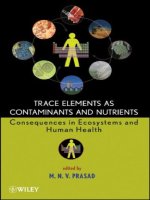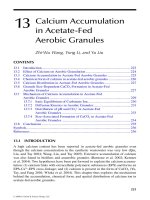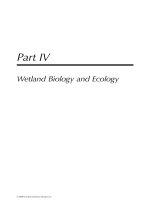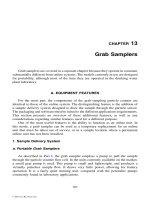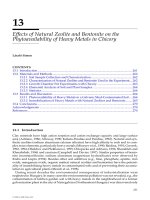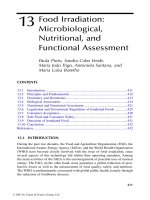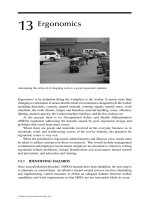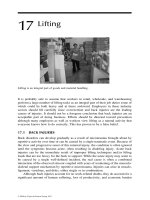Ecosystems and Human Health - Chapter 13 potx
Bạn đang xem bản rút gọn của tài liệu. Xem và tải ngay bản đầy đủ của tài liệu tại đây (58.34 KB, 16 trang )
©2001 CRC Press LLC
chapter thirteen
Radiation hazards
Introduction
The electromagnetic spectrum encompasses all forms of radiant energy.
Table 12 lists the various components and their wavelengths in decreas-
ing order.
Ionizing radiation, that portion of the spectrum that can cause serious
cell damage, includes all wavelengths of 1000 Å or less (see Table 12). Ion-
izing radiation, by stripping electrons from molecules as it passes through
tissues, produces ionized species of everything from H
2
O to macromolecules
like DNA. These ionized species are unstable and reactive, and can produce
dramatic disruptions in cell function, including mutation.
There is still controversy regarding the degree of risk. Radiophobia, an
illogical fear of radiation hazards, has led to considerable controversy over
the extent of the environmental risks of ionizing radiation. Consider the
following conflicting statements from Cobb (1989).
Table 12
Components of the Electromagnetic Spectrum
Type of Radiation Wavelength
Radio waves 30 km–3 cm
Microwaves 3 cm–10 mm
Thermal (heat) 0.078–0.001 mm
Infrared (includes thermal portion) 0.5 mm–10000 Å
Visible 7800–4000 Å
Ultraviolet 4000–1850 Å
Extreme ultraviolet 1850–150 Å
Soft X-rays 1000–5 Å
X-rays 5–0.06 Å
Gamma rays 1.4–0.01 Å
Cosmic rays (protons 85%, alpha particles 12%,
electrons, gamma rays, etc.
©2001 CRC Press LLC
• Dr. K.Z. Morgan, a pioneer in health physics: “It is incontestable that
radiation risks are greater than published.”
• C. Rasmussen, nuclear engineer at MIT: “There is a lot of evidence
that low doses of radiation not only don’t cause harm but may in
fact do some good. After all, humankind evolved in a world of
natural low-level radiation.” (About 82% of our total radiation
exposure come from natural sources.) This is another example
of hormesis.
• R. Guimond, EPA: “We can’t avoid living in a sea of radiation.”
In some cultures, deliberate exposure to natural-source radiation is done
in the belief that it has curative powers. In Japan, exposure to radon is
courted in “radon spas” where natural hotsprings occur.
Sources and types of radiation
Sources
Natural sources of radiation
Natural sources of radiation include cosmic rays from space, solar rays that
intensify during solar storms (sunspots), radiation emanating from rocks
and groundwater, and radiation coming from within our own bodies, mainly
from decay of radioactive potassium in muscle. Of considerable concern at
present is the exposure to radon gas, a radioactive decay product of radium,
a common radioactive element in soil and rock. This is discussed in more
detail below.
Man-made sources of radiation
Man-made sources of radiation include medical X-rays and radioisotopes,
ion sensors in smoke detectors, uranium used to provide the gleam in den-
tures, mantles in camping lanterns, radioactive wastes, nuclear accidents
(e.g., Chernobyl), and careless handling of nuclear materials. Cesium-137
was discarded in a dump in Brazil and ultimately killed 4 people and con-
taminated 249. Until fairly recently, radium was used to hand-paint luminous
watch dials. Workers used to “point” their brushes by running them between
their lips, a practice that led to cases of radiation sickness.
The cause of radiation
Elements that exist in an unstable form are continually decaying to more
stable ones. In the process, they give off energy in several ways. Ionizing
radiation arises when an unstable nucleus gives off energy. An unstable
nucleus is called a radionuclide. In contrast, X-irradiation is a form of cosmic
ray and also occurs when a suitable target such as tungsten is bombarded
with electrons. It does not arise from nuclear decay.
©2001 CRC Press LLC
Types of radioactive energy resulting from nuclear decay
1. A nucleus can eject two protons and two neutrons to lose mass and
convert itself into another element. The ejected components consti-
tute an alpha-particle. An alpha-particle is slow moving and will not
penetrate skin, but it can cause dangerous ionization if ingested. An
alpha-particle is actually identical to the nucleus of helium.
2. The neutron of a nucleus can lose an electron to become a positron.
The lost, negatively charged particle is called a beta-particle.
3. Even after emitting alpha- or beta-particles, a nucleus may remain
in an agitated state. It can rid itself of excess energy by giving off
gamma-rays. These are short, intense bursts of electromagnetic en-
ergy with no electrical charge. They can penetrate lead and concrete
and can cause extensive tissue damage by ionization.
4. Neutrons are ejected from the nucleus during nuclear chain reactions.
They collide and combine with the nuclei of other atoms and induce
radioactivity of the above types. This is the primary source of radio-
activity following a nuclear explosion.
Measurement of radiation
There are two different types of measurements of ionizing radiation. One is
concerned with the level of energy actually emitted from the source, and the
other is concerned with the amount of tissue damage that can be produced
by a particular form of radiation. The field is unfortunately further confused
by a more recent shift to the international (SI) system. The equivalent values
are shown in Table 13. They are not easily interchangeable.
Measures of energy
1. As the nucleus of an atom decays, it gives off a burst of energy (the
ionizing radiation) called a “disintegration.” The number of disinte-
grations per unit time varies with the nature of the source. Various
counting instruments (scintillation counters, etc.) measure disinte-
grations per minute (dpm). The basic unit of measuring radiation
Table 13
Equivalent Values, Old and New Systems
Old System New System (SI)
1 curie (Ci) 37 gigabecquerels (Gbq)
1 rem (rem) 10 millisieverts (mSv)
100 rem 1 Sievert (Sv)
1 rad (rad) 10 milligrays (mGy)
100 rad 1 gray (Gy)
1 roentgen (R) 258 millicoulombs/kilogram (mC/kg)
©2001 CRC Press LLC
energy is the curie (Ci) and it is the number of disintegrations
(3.7
×
10
10
) occurring in 1 second in 1 gram of radium-226. Radioiso-
topes used in science are usually provided in milliCi (mCi) amounts.
The new unit is the Becquerel (Bq). A Bq represents one disintegration
per second: 1 Ci = 37
×
10
9
Bq (37 gigabecquerels).
2. The first unit of radiation was the roentgen (R). It has a complicated
definition based on the amount of X-rays or gamma-rays required to
cause a standard degree of ionization in air.
Measures of damage
1. The earlier measure of radiation damage is the rem, which stands for
roentgen-equivalent-man. It is that amount of ionizing radiation of
any type that produces in humans the same biological effect as 1 R.
The new international unit is the sievert (Sv): 1 Sievert = 100 rem.
2. The rad is the amount of radiation absorbed by 1 gram of tissue. The
new international unit is the gray (Gy): 1 gray = 100 rad.
A rough scale of toxicity is as follows: 10,000 rem is rapidly fatal because
of damage to the central nervous system (CNS). Whole-body exposure to
300 rem is approximately the LD
50
. Between 100 and 300 rem, radiation
damage occurs. The assumption is made that the risk associated with radi-
ation is linear all the way to zero. When it comes to assessing carcinogenic
potential, however, accuracy is extremely difficult. Below 10 rem, effects are
unclear due to confounding factors such as smoking, pollution, and diet.
Over 300 agents have been shown to be carcinogenic in animal tests. Resi-
dents of Denver have lower cancer death rates than those of New Orleans
despite higher radiation exposures because of increased levels of cosmic
radiation at their high altitude.
Major nuclear disasters of historic importance
Hiroshima
The people from whom the most reliable data have been gathered concerning
radiation hazards are the survivors of the atom bomb dropped on Hiroshima
at 8:15 a.m., August 6, 1945. In 1947, the Radiation Effects Research Foun-
dation was established. Exhaustive studies have shown that the heavily
exposed people, called the “hibakusha,” had a 29% greater chance of dying
from cancer than normal. Excess numbers of leukemia cases began appearing
in the late 1940s and peaked in the early 1950s but by the early 1970s had
dropped to levels near those of unexposed Japanese. Now the surviving
hibakusha have longer life expectancies than the overall population, perhaps
because of closer medical supervision.
One of the most feared hazards of radiation is that of congenitally
deformed infants because of radiation-induced genetic defects in the mother.
©2001 CRC Press LLC
While such defects have been demonstrated experimentally, the Hiroshima
study compared 8000 children of hibakusha with 8000 of unexposed Japa-
nese and found an incidence of chromosome damage in 5/1000 of the former
and 6/1000 of the latter. Protective mechanisms may be functioning in
humans (e.g., spontaneous early abortion). Fetuses exposed
in utero
are a
different story. Dozens of mentally retarded infants were born in the areas
around Hiroshima and Nagasaki (target of the second atomic bomb) in the
months following the blasts. Spontaneous abortions were also numerous.
The fetus appears to be most vulnerable between 8 and 15 weeks.
One recent development, however, is that a special panel formed by the
U.S. National Research Council recently released a report following a reas-
sessment of the Hiroshima and Nagasaki data and concluded that the levels
of exposure were much lower than previously calculated. Original estimates
were based on tests at the Nevada nuclear test site using much flimsier build-
ings than were actually present in those cities. As a consequence, the estab-
lished safe limits have had to be revised downward. This is primarily a concern
for people exposed to radiation on the job, but it has revived the controversy
about whether there is any safe level of exposure. Ironically, evidence is now
surfacing that scientists and technicians who worked on the atomic bomb
project during the war are showing up with elevated incidences of cancer
which, when adjusted for exposure level, may be even greater than those of
the hibakusha. The new safe exposure limit is 20 mSv/yr averaged over 5
years with no more than 50 in any one year. The old level was 50 mSv/yr.
Chernobyl
The most recent and highly publicized nuclear disaster was Chernobyl in
April of 1986 (a much worse but largely concealed disaster occurred in
Russia in 1958). In this disaster, 20% of the plant’s radioactive iodine
escaped, along with 10 to 20% of its radioactive cesium and other isotopes.
Approximately 135,000 people lived in a 30-km radius of the power plant.
There were 30 deaths and 237 cases of severe radiation injury. Some 2000
children have been born to women who were living in the accident zone at
the time of the disaster. No abnormalities have yet been detected in them.
An examination of about 700,000 people over a wider area has thus far not
revealed any physical problems. Russian scientists estimate an increase in
the cancer rate of 0.04% over the next 20 years. In western Europe, exposed
to the drift of radioactive dust, it is estimated that, over the next 50 years,
1000 additional cancer deaths will occur. Normally, there would be
30,000,000 cancer deaths in this period, so the increase is 0.003%. Aside from
those people directly exposed to the effects of the explosion, the greatest
risk of exposure appears to come from eating contaminated food. Thousands
of reindeer had to be destroyed in northern Scandinavia because they had
grazed on contaminated pasture.
Dr. Marvin Goldwin, chief of the Joint-U.S Soviet Medical Team, made
the following points in a recent report.
©2001 CRC Press LLC
1. Everyone in the Northern Hemisphere received a small dose of ra-
diation. The degree of exposure of those people at highest risk cannot
be accurately identified.
2. Radioactive iodine posed an early risk to the thyroid glands of ex-
posed people.
3. As of 1991 their was no detectable increase in the incidence of cancer
but leukemia may yet show up and solid tumors may not show up
for 10 years.
Chernobyl provides another example of how psychological damage can
often exceed physical damage in an environmental disaster. Thousands of
people received a radiation exposure that exceeded the maximum recom-
mended lifetime allowance. Because radiation levels in their locales have
fallen to low levels similar to those of surrounding areas, it makes no medical
or scientific sense to relocate them. Stress and fear, however, create an under-
standable desire in these people to be moved out of the area, and their wishes
are presently being acted upon.
Three Mile Island
The partial core meltdown of the Unit 2 reactor at Three Mile Island in March
1979 was largely responsible for bringing the nuclear power program in the
United States to a halt. Of the “defense in depth” safety features, all but the
outer water shield failed. Some authorities claim that even a complete melt-
down would not have breached this defense. Despite concerns of nearby
residents, only 15 Ci of radioactivity were actually released. The news media
exploited the event with sensational reports of “deadly clouds of radioactive
gas” and made much of the potential for explosion of a large bubble of
hydrogen in the reactor. In fact, there was none because no oxygen was
present. The people at greatest risk from radiation were the workers who
were involved in the clean-up. U.S. federal regulations limit the maximum
exposure of workers in the nuclear industry to 12 rem per year. Workers in
the “hot” areas receive about 1 mrem per hour, the equivalent of one chest
X-ray. Totals for such workers in 1987 were about 710 millirem (see Chapter
2 for more on Three Mile Island).
The Hanford release
In contrast, massive amounts of iodine-131 were deliberately released (for
purposes still classified as top secret) from the military nuclear facility at
Hanford, Washington in the 1940s and 1950s. Some residents may have
received as much as 2295 rem. Again, the greatest source of exposure may
have been the consumption of contaminated meat and vegetables. Multimil-
lion-dollar studies have recently been commissioned to seek answers to the
degree of risk and to assign responsibility. Obviously, the potential for civil
action is considerable.
©2001 CRC Press LLC
The consistent elements present in all of these disasters, including the
discarding of cesium-137 in Brazil, have been human error, misjudgment,
and negligence. Deliberate callousness may have been involved at Hanford,
where charges of unsafe practices and antiquated, dangerous equipment are
still being made. Conversely, the real danger to the public has routinely been
overblown, and events have been exploited by the media and by antinuclear
groups. In the minds of many, nuclear reactors equate with nuclear bombs.
Radon gas: the natural radiation
As noted above, 82% of the ionizing radiation to which North Americans
are exposed comes from natural sources. It has been estimated that there is
enough natural radioactive material in the human body that, if it were a
laboratory animal, it would have to be disposed of as hazardous waste. The
average, annual, natural background exposure in Great Britain is about 1
mSv (0.1 rem or 100 mrem). In Canada, it is somewhat higher because the
Canadian Shield (the band of granite rock that spans mid-northern Ontario,
Quebec, and Manitoba) is rich in uranium deposits. Radon gas is by far the
largest potential health hazard from natural radiation. It is the decay product
of uranium and it seeps up through faults in the sub-strata of soil and may
leak into houses through cracks in basement walls, drains, etc. The advent
of airtight houses has increased the risk by trapping radon gas in the house.
In the British study, it was calculated that 1,000,000 people were exposed to
radon at levels of 5 to 15 mSv annually. In contrast, only 5100 workers in
nuclear industry were exposed to levels as high or higher. This is the equiv-
alent of 50 to 150 chest X-rays annually. Radon homes are distributed very
randomly, with highly contaminated homes located right beside radon-free
ones. The federal government conducted a survey of Canadian homes and
found that Winnipeg had the highest radon levels of any Canadian city, with
high levels also found in parts of Saskatchewan and northern Ontario and
Quebec (see Table 14). Toronto (in Ontario) has low levels.
A map of radon risk areas in the United States, published by National
Geographic, shows a band running slightly east of North through the middle
of Ohio, and another running east-west through New York state. A U.S.
federal study surveyed 20,000 homes in 17 states and found that 25% had
potentially hazardous levels of radon. Radon was described as the largest
environmental radiation health hazard in America. Debate over the degree
of risk plagues this area, as it does others. The EPA study measured radon
levels in basements where they would be highest. Calculations of risk have
estimated the lifetime risk of dying from radon-induced cancer at 0.4% for
exposed individuals, which is the same as one’s chances of dying in a fire
or a fall. If radon were a man-made carcinogen, it would unquestionably be
banned, and most certainly would be the target of anti-nuclear activists.
Nevertheless, there is still controversy regarding the degree of risk, or per-
haps more correctly, the degree of exposure. A British study calculated that
6 to 12% of all myeloid leukemias might be attributed to radon exposure,
©2001 CRC Press LLC
with levels rising to 23 to 43% in Cornwall, where the highest exposures
occur. Worldwide, their calculations suggested 13 to 25% of all myeloid
leukemias in all age groups could be due to radon.
In 1984, a construction worker at the Limerick nuclear generating station
near Reading, Pennsylvania consistently set off radiation alarms despite the
fact that he had never worked in a “hot” area. An examination of his home
subsequently revealed radon levels of 2600 pCi/L, the highest ever recorded.
North Dakota, with 63% of homes showing levels of 4 pCi/L or greater,
leads the United States in radon exposure, followed by Minnesota (46%),
Colorado (39%), Pennsylvania (37%), and Wyoming and Indiana (26%). After
cigarette smoking, radon is probably the most common cause of lung cancer.
Radon-222 (
222
Rn) and
220
Rn are the only gaseous decay products of uranium.
Their half-life is 3.8 days and they decay to particles (not gases), including
radioactive poloniums, which actually are the alpha-emitting toxins that
cause cell damage. Alpha-particles, unlike gamma-rays, can only cause cell
damage for a radius of about 70
µ
, hence the risk of lung cancer. The
increased incidence of leukemias is difficult to explain on this basis.
Tissue sensitivity to radiation
In general, tissues with a high rate of turnover are more susceptible to the
effects of ionizing radiation. Thus, thyroid, lung, breast, stomach, colon, and
bone marrow have high sensitivity; brain, lymph tissue, esophagus, liver,
pancreas, small intestine, and ovaries are intermediate; and skin, gall bladder,
spleen, kidneys, and dense bone are low. This order of sensitivity roughly
parallels the frequency of primary cancer in these tissues. If molecular dis-
ruption is sufficient, the cell will die. Because hair follicles and gastrointestinal
mucosa have high turnovers, radiation sickness involves hair loss and severe
diarrhea. Because bone marrow cells also have a high turnover, repair of
Table 14
Radon Concentrations in Canadian Homes in, pCi/L Air
City
No. Homes
Tested
No. Homes
>4.5 pCi/L %
St. Lawrence, P.Q. 432 63 14.6
Sherbrooke, P.Q. 905 64 7.1
St. John, N.B. 866 51 5.9
Fredricton, N.B. 455 26 5.7
Thunder Bay, Ont. 627 29 4.6
Charlottetown, P.E.I. 813 35 4.3
Sudbury, Ont. 722 29 3.8
St. John’s, NFL. 585 17 2.9
Montreal, P.Q. 600 9 1.5
Quebec, P.Q. 584 9 1.5
Toronto, Ont. 751 1 0.1
Vancouver, B.C. 823 0 0
Compiled from data reported by McGregor et al.,
Health Physics
, 39, 285–299, 1980.
©2001 CRC Press LLC
DNA may not be complete before replication occurs and the daughter cells
may be malignant. This is why leukemia is the commonest cancer associated
with radiation injury.
Questions regarding the safety of the nuclear industry continue to
emerge. In August 1989, two workers at the Pickering Nuclear Plant in
Ontario were mistakenly given unshielded practice equipment to change a
new type of fuel rod just recently introduced. They received what were
widely reported as the highest levels of radiation ever encountered by work-
ers in the Canadian nuclear industry: 5.6 and 12.2 rem. The annual allowable
limit set by the Atomic Energy Commission is 2 rem. The radiation exposure
from an average chest X-ray is 15 mrem. This has been calculated (theoret-
ically) to cause one additional cancer per 100,000,000 population. In other
words, if the entire population of North America were to receive one chest
X-ray, one could expect three additional cancer cases as a result. These
workers received about 700 times this amount, which would cause one
additional cancer per 143,000 people. This risk would be lessened if they
were removed to areas where there is no possibility of additional exposure
for at least 1 year. The safety maxim that should apply in all situations
involving exposure to radiation is ALARA (as little as reasonably achiev-
able). It should be noted that, once again, human error was responsible for
this accident.
In Great Britain, a disturbing report was released in early 1990 to the
effect that offspring of nuclear plant workers had an increased incidence of
birth defects. Because these children are not directly exposed to radioactive
material, the conclusion, if the data are correct, is that exposure of the parents
(mostly men) caused genetic damage. These results contradict earlier studies,
and it has been pointed out that clusters of birth defects occur geographically
in the absence of nuclear generators (or other identifiable causes). The data
will be of concern until they can be explained or disproved. Public pressure
has resulted in the cancellation of 50 new nuclear power plants in the United
States. As a result, there is greater reliance on coal-fired generators. Approx-
imately 200 coal miners die each year in mine accidents and an equal number
from black lung disease (pneumoconiosis). Recent (1992) mine accidents
include 26 killed in Nova Scotia, 400 in Turkey, and 38 in Russia. Such events
rarely cause a ripple of concern among opponents of nuclear energy. There
is also the problem of acid rain resulting from sulfur pollution of the atmo-
sphere by coal-fired generators. Has the public traded a potential but high-
profile risk for a real and greater one that is less visible? Table 15 compares
various sources of radiation encountered by Americans.
Microwaves
Microwaves are the shortest waves in the radio portion of the electromag-
netic spectrum (1 mm–30 cm). They are at very high frequencies
(1000–300,000 megacycles/s) and are used in radar, for long-distance trans-
mission of phone and TV signals, and, of course, in microwave ovens.
©2001 CRC Press LLC
Because of its high dielectric constant, water dissipates energy as heat
when exposed to microwaves. At high enough energies, thermal damage
may occur in living tissues. Recent concern has been expressed over possible
carcinogenic effects of microwaves given off by cellular phones. The energy
level is so low (<5 watts), however, that no thermal effects can be detected.
Little information is available concerning non-thermal effects of microwaves,
but evidence for carcinogenicity is scanty and anecdotal.
Ultraviolet radiation
Ultraviolet radiation occupies the electromagnetic spectrum between 400
and 4 nm: UVA, 400–320 nm; UVB, 320–280 nm; UVC, <280 nm. An increase
of 1 to 2% of UVB radiation is associated with an increase of 2 to 4% in skin
cancer. UVB is in the ionizing radiation range and can therefore damage
DNA, leading to mutations and cancer. The effect on melanocytes appears
to be more complicated. Melanomas often appear first at sites not directly
exposed to sunlight. Tropical and subtropical areas have much higher inci-
dences of skin cancer than temperate zones. In North America, it has been
claimed that the incidence of skin cancer has increased by 400% in recent
years, presumably because of the destruction of the ozone layer.
Medical uses of UV radiation
1. Photophoresis, in which blood is removed from a patient and ex-
posed to UV light, then returned to the patient, is useful for treating
mycosis fungoides, a complication of skin cancer, and it is promising
for some leukemias.
2. UVA is used in conjunction with a photosensitive drug called
psorelen to treat the skin lesions of psoriasis. The technique is called
PUVA (psorelen-UVA).
Table 15
Average Annual U.S. Doses
Source Dose
Natural sources <100 mrem
Medical and dental X-rays 78 mrem
Radioisotopes 14 mrem
Weapons testing 4–5 mrem
a
Nuclear industry <1 mrem
Building materials (brick and masonry) 3–4 mrem
Total average annual exposure ~200 mrem
1 chest X-ray 10–15 mrem
a
Much higher at downwind locations in Nevada, Utah, etc.
©2001 CRC Press LLC
Extra-low-frequency (ELF) electromagnetic radiation
ELF waves are nonionizing radiation waves with extremely long wave-
lengths (several hundred kilometers) and very low frequencies (<300 Hz).
Exposure to artificial ELF fields occurs near high-tension electrical lines and
much lower levels emanate from household appliances. Electric blankets, in
particular, are thought to be potent sources of ELF exposure because of the
close proximity and prolonged contact they entail. Other types of low-
frequency waves include microwaves, emissions from TVs, and radio-fre-
quency fields. High-tension lines create both electrical and magnetic fields
and, although insulation will shield the former, the latter have great pene-
trating powers and will penetrate the human body. The unit of measure of
magnetic fields is the gauss, which has a very complicated definition. Elec-
tromagnetic fields are also measured in volts per meter (V/m). The field
immediately below a 400,000-V transmission line is 10,000 V/m, dropping
to 500–1000 V/m at a distance of 100 m.
Numerous studies have shown deleterious effects from low levels of ELF
radiation, including deformities of chick embryos, behavioral alterations,
and physiological changes. Mice and snails have shown increased sensitivity
to heat following exposure to ELF. Experimental findings have not always
been consistent, however. Calcium uptake by cells is inhibited in some sys-
tems. Most of these studies employed exposures ranging from 30 milligauss
(the level emitted by some electric blankets) to 1 gauss, and exposure times
ranging from 30 minutes to several days or weeks (in the case of the chick
embryo studies). The field strength of the Earth is about 0.3 to 0.6 gauss.
The greatest controversy concerns the interpretation of epidemiological
data. Several studies have been conducted that purport to show increased
incidences of cancer, especially leukemia, recurrent headache and depres-
sion, congenital deformities, and other health problems in people living near
high-voltage power lines or in high-exposure working environments. These
studies have been reviewed by several epidemiologists and have been
faulted on several counts, including failure to account for other risk factors,
failure to balance control and test groups, and the use of inappropriate
statistics. In particular, the use of the Proportional Mortality Rate (PMR) has
been criticized. This is the practice of expressing mortality rates due to certain
causes as a percentage of the total. With this method, a decrease in one cause,
(e.g., traffic accidents) leads to an apparent increase in the other causes
although none has actually occurred, or even when a decrease has occurred.
Most reviewers concede that there is some evidence of a marginal increase
in the risk of leukemia in electrical workers, but qualify this by stating that
the question remains open. This has not discouraged Paul Brodeur, a staff
writer for the
New Yorker
, from recently publishing a book on the subject
entitled
Currents of Death
, to follow up on his previous success with
The
Zapping of America
on the subject of the hazards of video display terminals.
©2001 CRC Press LLC
Two studies in 1988 provided further conflicting evidence. One, con-
ducted in Washington state, found no correlation between the incidence of
acute lymphocytic leukemia and exposure to electromagnetic radiation from
high-voltage power lines located within 140 feet of homes, whether com-
pared to actual measures within the homes or to computed values based on
the wiring configurations. The other, conducted in Colorado, looked at
cancer incidences in children 14 years old and under and found no associ-
ation between total cancer incidence and exposure levels, but did find a
modest association for lymphomas and sarcomas. The situation was not
clarified at a 1992 meeting in San Diego at which a Swedish group, using
more accurate data regarding exposure levels than had been previously
available, showed a correlation between exposure and cancer incidence.
Conversely, a literature study commissioned by the U.S. Government found
no convincing evidence of an increased cancer risk for exposure to ELF or
electromagnetic fields (EMFs).
The results of a massive study of some 224,000 utility workers in Quebec,
Ontario, and France were released in the spring of 1994. This was a case-
control study in which 4151 new cancer cases identified during the study
period were matched with 6106 cancer-free controls from the same popula-
tion to eliminate confounding factors such as smoking, etc. Past exposure to
electromagnetic fields (EMFs) was documented. There was no association
observed between the overall cancer incidence and past EMF exposure. This
was true for lymphoma, melanoma, lung, stomach, and colon cancer. There
was a statistically significant association between cumulative exposure and
a rare form of adult leukemia (acute non-lymphoid leukemia) and its sub-
type, acute myeloid leukemia. Risk was increased by a factor of 2.41 but a
causal relationship was not demonstrated. The level of significance, more-
over, was at the 95% confidence limit, which is usually considered to be the
minimum acceptable. There was a nonsignificant association cumulative
exposure to the highest levels of EMF and astrocytoma, a rare brain cancer.
Given the size of this study, it seems unlikely that any more conclusive
evidence will be forthcoming any time soon.
Conflicting findings continue to be reported. In 1999, a study in Toronto,
conducted by the Hospital for Sick Children, reported that children exposed
to high levels of electromagnetic radiation had an incidence of leukemia 2
to 4 times higher than did children not so exposed. In contrast, a similar
study conducted in British Columbia did not find any association between
exposure level and leukemia incidence.
One rather oddball theory attempts to associate geographic areas of high
electromagnetic fields with deep underground tension between tectonic
plates of the earth. One such area is in Canada, and the suggestion (largely
unfounded) is that these areas are associated with luminous atmospheric
phenomena, UFO reports, and increased incidence of cancer — notably
brain tumors.
©2001 CRC Press LLC
Irradiation of foodstuffs
The use of ionizing radiation to preserve foodstuffs by killing spoilage micro-
organisms was proposed as early as 1905 when British Patent No. 1609 was
issued to “J. Appleby, Miller, and A.J. Banks, analytical chemist.” They noted
that sterilization might be accomplished in the complete absence of foreign
chemicals. It was not until the post-war arrival of the “atomic age,” however,
that sources of ionizing radiation were sufficiently abundant to make this
procedure practical and economical. In the immediate post-war era, there
was considerable public enthusiasm for the development of nuclear technol-
ogy for peaceful purposes, and there was good acceptance of the notion of
irradiated foods such as milk and vegetables. By 1965, the United States,
Canada, and the Soviet Union had approved the marketing of certain foods
treated with low-dose irradiation but no manufacturers had taken advantage
of this situation. By this time, the health concern over strontium-90 levels in
milk was widely known, the anti-nuclear movement was in full swing, and
radiophobia was growing. Acceptance of irradiated foods was in rapid
decline, and it became replaced with concerns over potential health hazards.
These concerns tended to fall into three areas:
1. Foods would be made radioactive and those who consumed them
might develop radiation sickness.
2. Foods might be altered in some way, rendering them toxic, even
carcinogenic.
3. Microorganisms could mutate to new and horrific pathogenic forms.
The first objection is easily dismissed. Foods are not rendered radioactive
by low-dose ionizing radiation. Extensive toxicological testing, including
tests for carcinogenicity, over several decades led a United Nations Joint
Expert Committee on Irradiated Foods to conclude in 1980 that “… the
irradiation of any food commodity up to an overall average dose of 10 kGy
presents no toxicological hazard; hence, toxicological testing of foods so
treated is no longer required” (Diehl, 1990). The second objection is therefore
readily disposed. The third concern stems from experimental evidence that
pure, dilute solutions of glucose become mutagenic for
Salmonella typhimu-
rium
after irradiation, and that polyunsaturated fats, in an oxygen atmo-
sphere, form lipid peroxides when irradiated. Neither change has ever been
noted in complex food materials. Nor is there any evidence of a direct
mutuganic effect on microorganisms by ionizing radiation under the condi-
tions in which it is employed. Nevertheless, resistance to irradiation varies
greatly from bacterium to bacterium, with spore formers such as
Clostridium
botulinum
being very resistant. Ionizing radiation is thus more likely to be
more useful in preventing spoilage than in eliminating potential pathogenic
organisms. Public acceptance of irradiated foods remains a problem.
The pendulum may be swinging back toward acceptance of irradiation
of foods. Several large outbreaks of so-called “hamburger disease,” resulting
©2001 CRC Press LLC
from contamination of ground beef by strain O157:H7 of
E. coli
, have led
to the use of irradiation of ground beef. In June 2000, 77 metric tons of
ground beef were recalled from a number of supermarket chains in Canada
because of
E. coli
O157:H7 contamination. The public may be becoming
aware that this is a far greater and very real health risk than any posed by
irradiated food.
Further reading
Bailey, C.C.,
The Aftermath of Chernobyl
, Kendall/Hunt, Dubuque, IA, 1989.
Bithell, J.F., Dutton, S.J., Draper, G.J., and Neary, N.M., Distribution of childhood
leukemias and non-Hodgkin’s lymphomas near nuclear installations in
England and Wales,
Br. Med. J
., 309, 501–505, 1994.
Bowie, C. and Bowie, S.H., Radon and health,
Lancet
, 1, 409–413, 1991.
Cobb, C.E., Living with radiation,
National Geographic
, 175 (Apr.), 403–437, 1989.
Cole, L., Much ado about radon,
The Sciences
, Jan/Feb, 19–23, 1990.
Diehl, J.F.,
Safety of Irradiated Foods
, Marcel Dekker, New York, 1990.
Dowson, D.I. and Lewith, G.T., Overhead high voltage cables and recurrent headache
and depressions,
Practitioner
, 232, 435–436, 1988.
Editorial. Living under pylons,
Br. Med. J
., 297, 804–805, 1988.
Eijgenraam, F., Chernobyl’s cloud: a lighter shade of gray,
Science
, 252, 1245–1246,
1991.
Henshaw, D.L., Eatough, J.P., and Richardson, R.B., Radon as a causative factor in
induction of myeloid leukemia and other cancers,
Lancet
, 335, 1008–1012, 1990.
Jerrard, H.G. and McNeill, D.B., Eds.,
Dictionary of Scientific Units
, 6th ed., Chapman
& Hall, London, 1992.
McGregor, R.G. et al., Background concentrations of radon and radon daughters in
Canadian homes,
Health Physics
, 39, 285–289, 1980.
Michaelson, S.M., Influence of power frequency electric and magnetic fields on hu-
man health, in
Environmental Sciences
, Sterrett, F.S., Ed., New York Academy
of Sciences, Vol. 502, 55–75, 1987.
Pool, R., Electromagnetic fields: the biological evidence,
Science
, 249, 1378–1381, 1990.
Report of the Working Group on Electric and Magnetic ELF Fields. Electric and
Magnetic Fields and Your Health. Publ. # H46-2/89-140E, Min. Supply and
Services Canada, 1990.
Rutkowski, C.A. and Del Bigio, M.R., UFOs and cancer?
CMAJ
, 140, 1258–1259,1989.
Savitz, D.A. et al., Case control study of childhood cancer and exposure to 60-Hz
magnetic fields,
Am. J. Epidemiol
., 128, 21–39, 1988.
Severson, R.K., Acute nonlymphocytic leukemia and residential exposure to power
frequency magnetic fields,
Am. J. Epidemiol
., 128, 10–20, 1988.
Shore, R.E., Electromagnetic radiations and cancer. Cause and prevention,
Cancer
, 62,
1747–1754, 1988.
Smith, H., ICRP publ. 50. Lung cancer risk from indoor exposures to radon daughters,
J. Can. Assoc. Radiol
., 39, 144–147, 1988.
Stone, R., Can a father’s exposure lead to illness in his children?
Science
, 258, 31, 1992.
Stone, R., Polarized debate: EMFs and cancer,
Science
, 258, 1724–1725, 1992.
Tar-Ching, A.W., Living under pylons,
Br. Med. J
., 297, 1469–1470, 1988.
Theriault, G., Goldberg, M. et al., Cancer risks associated with occupational exposure
to magnetic fields among electric utility workers in Ontario and Quebec,
Canada and France: 1970–1989,
Am. J. Epidemiol
., 139, 550–572, 1994.
©2001 CRC Press LLC
Tronnes, D.H. and Seip, H.M., Health risks caused by indoor radon exposure, in
Risk
Assessment of Chemicals in the Environment
, Richardson, M.L., Ed., Royal So-
ciety of Chemistry, London, 1988, chap. 16.
Wertheimer, N. and Leeper, E., Magnetic field exposure related to cancer subtypes,
in
Environmental Sciences
, Sterrett, F.S., Ed., New York Academy of Sciences,
Vol. 502, 43–54, 1987.
Review questions
Questions 1 to 8, use the following code:
A if statements a, b, and c are correct
B if statements a and c are correct
C if statements b and d are correct
D if only statement d is correct
E if all statements (a, b, c, d) are correct
1. a. Gamma-rays have a longer wavelength than microwaves.
b. Ionizing radiation includes all wavelengths of 1000 Å or less.
c. Only a small fraction of radiation comes from natural sources.
d. Ionizing radiation strips electrons from molecules as it passes
through tissues.
2. a. Alpha-particles consist of two neutrons and two protons.
b. An alpha-particle is identical to the helium nucleus.
c. Gamma-rays have no charge.
d. Beta-particles have no charge.
3. a. A roentgen defines the amount of ionization in air caused by any
radiation.
b. rem stands for “reactive emission material.”
c. Predicting the carcinogenic potential for radiation is very difficult
below 10 rem.
d. ALARA stands for “always let active radiation alone.”
4. a. The main source of radon in the environment is nuclear power
plants.
b. Alpha-emitting daughters of radon bind to dust particles that
lodge in the lung.
c. Strontium-90 poses no threat to human health.
d. Radon daughters are likely the second-most common cause of
lung cancer after smoking.
5. a. In some geographic areas, the public may get higher radiation
exposures than most nuclear power plant workers.
b. The thyroid gland is very sensitive to radiation damage.
c. Neutrons given off during radioactive decay may collide with
other atoms to induce alpha, beta, and gamma radiation.
d. Smoke detectors contain a radioactive component in the ion
detector.
©2001 CRC Press LLC
6. a. Alpha-particles cause tissue damage only over a very short dis-
tance (70
µ
).
b. Tissues with a rapid turnover are most vulnerable to radiation
damage.
c. Tissues sensitive to radiation damage include hair follicles, bone
marrow, and gastrointestinal mucosa.
d. Safe limits for radiation exposure have been reduced recently
because of new evidence that low exposures cause cancer in mice.
7. a. Extra-low-frequency (ELF) electromagnetic radiation is emitted
by high-voltage power lines.
b. Evidence that ELF radiation causes cancer is inconclusive.
c. ELF radiation has been shown to adversely affect many biological
systems in single-celled organisms and chick embryos.
d. ELF radiation is given off by electric blankets.
8. a. Fruit are sometimes irradiated to prevent spoilage.
b. Low-level irradiation has been shown conclusively to induce mu-
tation in several species of bacteria.
c. Lipid peroxides have been shown to form from polyunsaturated
fats
in vitro
but not
in vivo
.
d. Irradiated food becomes radioactive.
Answers
1. C
2. A
3. B
4. C
5. E
6. A
7. E
8. B
